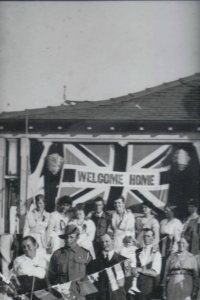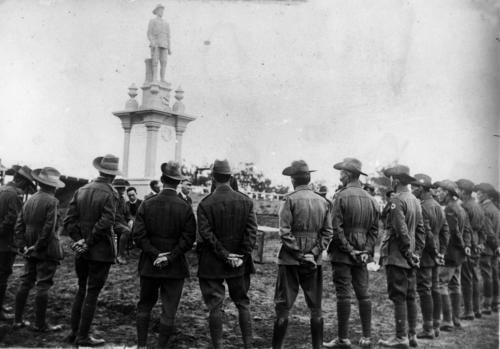Today as the sun rises around the country, people will gather to remember the men and women who’ve served in Australia’s wars over the years. However, the particular focus will be on the centenary of the cessation of conflict in the War to end all Wars. Hand crafted poppies will blanket memorials to represent each life lost to our then-young nation. Churches with bell towers are rarer in Australia than overseas, but at least some will ring out in commemoration, and bugles will play the Last Post.

I have a mental image of men on the battlefields sinking to the ground in relief and exhaustion, remembering the daily horrors and the lives of mates lost. At home, it must have been a mix of complex emotions, as families realised that their men-folk may soon be home, yet some would never come home, and their graves never seen. War memorials in every town, large and small, would serve in lieu of graves and a locus of remembrance.

With a national population of some 4.9million, about 420,000 or 38.7% of men between 18 and 45 would enlist, over 60,000 died and few would return uninsured in mind or body.
The mantra on Remembrance Day is “Lest We Forget”. Entirely appropriate but let’s also be realistic about what we’re remembering.
* those who would return home devastated in mind and/or body, some with visually horrific injuries. Others would have equally horrific mental injuries, perhaps evident only to their families. What inter-generational impact would this have on the affected families in an era when our knowledge of Post Traumatic Stress Disorder (PTSD) was unknown and unacknowledged?
* young women who would never marry or have children due to the loss of a sweetheart or the opportunity to have one, with a reduced male population.

* the mixed feelings of families who’d lost loved ones. Pride that they had served when called, yet tempered by seeing other young men (and women) return home. The undercurrents of those feelings in a community. No wonder so many bereaved families threw themselves into building memorials.
* the lack of understanding about just how devastating the war had been on the countryside where battles were fought. This is evident as the bereaved begged for their loved ones’ belongings, not realising even their bodies had been destroyed.
”we have lost 2 sons on active service and peace brings with it no hope for the return of our dear ones…we long for something personal from our second son’s effects” (Service record for Erle Victor Weiss #11147. Letter written by father Walter H Weiss, Erina Pubic School)

* the pathos of a family asking that their deceased sons be buried together irrespective of where they were killed.
”my sons were never parted in life, left Australia together, died together (on 4 Oct 1917).” Letter by father JA Gavin of Longreach about his sons James TB Gavin #6191 and GGB Gavin #6188. Buried Ypres Reservoir Cemetery VII B 1A and 3 respectively. “Lovely in their lives, In death undivided, to awake to Eternal Glory”.
* the names given to children, streets and towns which memorialise battles or the foreign places where they occurred.
* the hyperbole of war which holds that courage was all, they were never terrified, never left their posts or lost their minds: Empire above all. Valour is surely reflected equally in facing one’s fear.
* the loss to our young nation of so much human potential.
Let us remember them with honesty and compassion and recognise their contribution to our history and culture. May our compassion extend to the families of other nations who also lost loved ones in this horrendous war.

Sources:
World War 1 service records digitised on the National Archives of Australia website. Naa.gov.au
Australian War Memorial awm.gov.au
Commonwealth War Graves Commission website cwgc.org
Pauleen – beautifully said. Valerie
LikeLike
Thanks Valerie.
LikeLike
Beautifully written and so pertinent. Today is not about glorifying war in any way, but about paying our respects to all who served and all who waited…. and remembering the heartache felt by all nations.. hoping we have learnt many lessons from those terrible times.
LikeLike
Thanks Chris. I wish I felt we had learned lessons but I’m not sure.
LikeLiked by 1 person
We can but hope and do what we can in our own circles to try to accept our differences without condemnation. Easily said, but so hard to do.
LikeLiked by 1 person
Thanks Pauleen for this reminder of the real cost of war, and how its legacy affects subsequent generations. Good article. Well done.
LikeLiked by 1 person
Thanks David.
LikeLike
Beautiful, Pauleen.
LikeLike
Beautiful, Paulieen.
LikeLike
Thanks Lilian.
LikeLike
Thanks Kirralee.
LikeLiked by 1 person
Written from a hospital bed – you are one thoughtful lady. I agree with your sensible sentiments. We must never forget but we must not glorify war.
LikeLike
Thanks Jill.
LikeLike
Thank you Pauleen. A beautiful reminder to us all.
LikeLike
Thanks Nola.
LikeLike
I have included your blog in INTERESTING BLOGS in FRIDAY FOSSICKING at
https://thatmomentintime-crissouli.blogspot.com/2018/11/friday-fossicking-16th-november-2018.html
Thank you, Chris
LikeLike
Thanks Chris.
LikeLiked by 1 person
You’re welcome, Pauleen.
LikeLike